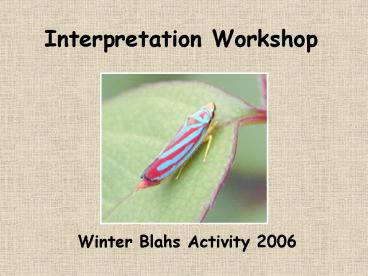Interpretation Workshop - PowerPoint PPT Presentation
1 / 15
Title:
Interpretation Workshop
Description:
... Centre is where all of the diets are prepared for the Zoo's animals. ... carnivore/feline diets, mealworms, crickets, and commercially prepared Zoo diets ... – PowerPoint PPT presentation
Number of Views:43
Avg rating:3.0/5.0
Title: Interpretation Workshop
1
Interpretation Workshop
- Winter Blahs Activity 2006
2
Education Mission
We will connect people to nature through our
plants and animals and create changes in
audience behaviour, knowledge and attitudes that
help ensure a positive future for people,
wildlife and wild places.
3
What are we trying to do?
4
Interpretation is the way to go!
- Interpretation is a process that creates
emotional and intellectual connections between
the audience and the meanings inherent in the
resource - Interpretation makes information come alive,
rather than simply communicating factual
information.
5
Principles of Interpretation
- Connect
- Provide more than information
- Its an art
- Provocation
- Present the whole
- Dont dilute
6
Know your Audience
- Sensory involvement
- Humour (where it is appropriate and makes a
relevant point) - New information made understandable
- An enthusiastic interpreter
7
Stages of Child Development
Ages 2-7 magic and fantasy self-oriented the
world seems to be alive!
Ages 7-11 simple relationships reasoning
dominated by personal experience ability to
classify develops time relationships more
understandable
- Ages 12-15
- Child thinks like an adult
- includes conceptual reasoning
- Peer acceptance very
- Important
- Can be noisy and awkward
8
Informing Giving Facts
- A Century Plant spends most of its life as a
rosette. Characteristic of other Agaves, its
flowering is delayed. When it does flower it
grows very quickly until it reaches 5 to 15 feet
in height. The plant blooms for several weeks
and then dies.
9
Storytelling Interpretation
10
Informing Giving Facts
- The Siberian tiger like other cats have large
eyes on the front of their faces. The incisors
are small and unspecialized, the canines are
elongate, sharp and slightly recurved. - Siberian tigers weigh up to 272 Kg.
11
Using Biofacts Interpretation
12
Informing Giving Facts
- The Animal Nutrition Centre is where all of the
diets are prepared for the Zoos animals. - Diets are formulated by an animal nutritionist to
ensure the collection stays healthy - Food includes fruits, vegetables,
carnivore/feline diets, mealworms, crickets, and
commercially prepared Zoo diets
13
Interpretation
14
Delivering Conservation Education
Bridge Body Conclusion
- POW!
15
(No Transcript)































